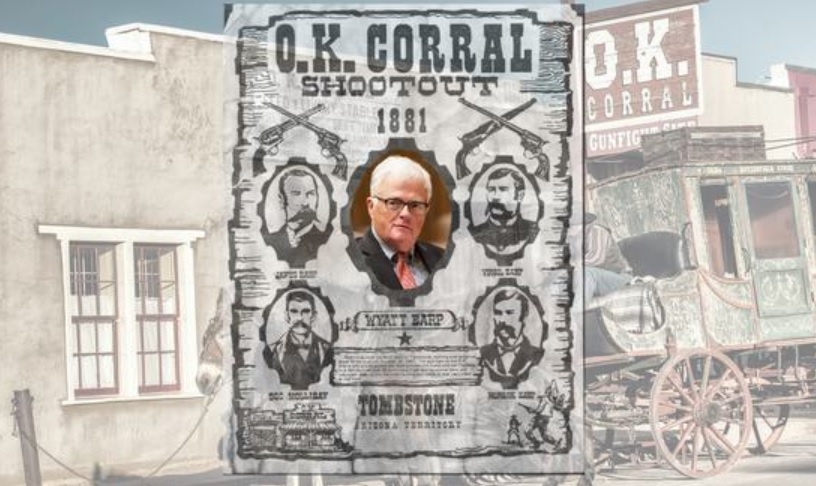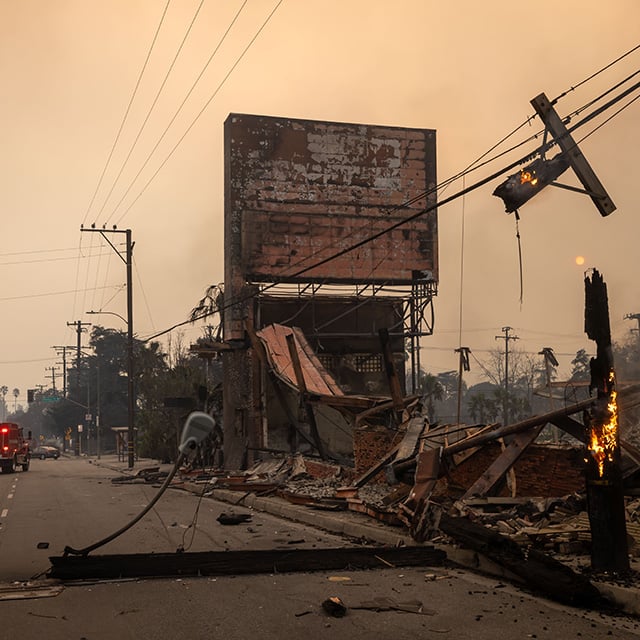Shootout at the Alsup Corral: Dissecting the Judge's 'My Best v. Your Best' Patent Approach
What really goes on in Judge William Alsup's so-called shootouts where accused infringers may wind up in "injunction city."
December 18, 2018 at 09:15 PM
3 minute read
The original version of this story was published on Law.com
 Photo illustration: Jason Doiy/ALM
Photo illustration: Jason Doiy/ALM
As my former ALM colleague Ginny LaRoe pointed out many years ago, U.S. District Judge William Alsup is a courtroom scientist who especially enjoys making bold experiments in patent cases. On Monday I learned about his latest innovation.
Alsup calls it the shootout. He instructs the patentee to pick its strongest asserted claim and the accused infringer to pick the weakest. The judge then conducts summary judgment and trial—if necessary—on an expedited schedule. This was the procedure that led to Friday's defense verdict for Juniper Networks in a cybersecurity dispute with Finjan.
Alsup has been conducting shootouts since at least 2017, but the Finjan case provides the judge's rationale in his own words. As Alsup explained back in February, few patent cases are close calls that require a jury trial. In two out of three, it turns out that one side is “way off base,” Alsup said, according to a transcript.
➤➤ Want to receive Skilled in the Art by email? Sign up here.
Under the shootout, if the accused infringer defeats the patent owner's strongest claim, the accused infringer might get sanctions. “And they will have to pay that right off the bat. Could be hundreds of thousands of dollars for having brought a bogus claim.”
Conversely, if the patent owner prevails, “it's injunction city,” Alsup said. “You don't have to wait until the end of the case. Whamo, the product goes off the shelf.”
“So this is why it's called a shoot-out,” the judge explained. “It's like the shoot-out at the OK Corral in Tombstone, Arizona. Where the lawyers go in there and they just shoot it out and one of them comes out alive.”
Alsup then thought better of that. “That's a terrible example to use these days so I'm going to take that back. Maybe I'll call it something else.”
One other benefit, according to the judge: Once accused infringers start targeting the weakest claims, patent owners often start dropping them from the case, which simplifies things, Alsup said. “This gets to the heart of the matter so quickly and so cleanly, instead of you all treating me like your early neutral evaluation judge and two years later I'm still trying to figure out which end is up,” the judge said.
“So that's the way we're going to proceed,” Alsup concluded. “Go back and tell your clients that the day of reckoning is close at hand.”
We hope you enjoyed this excerpt from Skilled in the Art, where Scott Graham digests the latest developments on everything IP and helps make sense of the trends, data, and politics around patents. Not a subscriber yet? Sign up for a free trial.
This content has been archived. It is available through our partners, LexisNexis® and Bloomberg Law.
To view this content, please continue to their sites.
Not a Lexis Subscriber?
Subscribe Now
Not a Bloomberg Law Subscriber?
Subscribe Now
NOT FOR REPRINT
© 2025 ALM Global, LLC, All Rights Reserved. Request academic re-use from www.copyright.com. All other uses, submit a request to [email protected]. For more information visit Asset & Logo Licensing.
You Might Like
View All
'A Death Sentence for TikTok'?: Litigators and Experts Weigh Impact of Potential Ban on Creators and Data Privacy

Shareholder Democracy? The Chatter Musk’s Tesla Pay Case Is Spurring Between Lawyers and Clients
6 minute read

Many LA County Law Firms Remain Open, Mobilize to Support Affected Employees Amid Historic Firestorm
Trending Stories
- 1'A Death Sentence for TikTok'?: Litigators and Experts Weigh Impact of Potential Ban on Creators and Data Privacy
- 2Bribery Case Against Former Lt. Gov. Brian Benjamin Is Dropped
- 3‘Extremely Disturbing’: AI Firms Face Class Action by ‘Taskers’ Exposed to Traumatic Content
- 4State Appeals Court Revives BraunHagey Lawsuit Alleging $4.2M Unlawful Wire to China
- 5Invoking Trump, AG Bonta Reminds Lawyers of Duties to Noncitizens in Plea Dealing
Who Got The Work
J. Brugh Lower of Gibbons has entered an appearance for industrial equipment supplier Devco Corporation in a pending trademark infringement lawsuit. The suit, accusing the defendant of selling knock-off Graco products, was filed Dec. 18 in New Jersey District Court by Rivkin Radler on behalf of Graco Inc. and Graco Minnesota. The case, assigned to U.S. District Judge Zahid N. Quraishi, is 3:24-cv-11294, Graco Inc. et al v. Devco Corporation.
Who Got The Work
Rebecca Maller-Stein and Kent A. Yalowitz of Arnold & Porter Kaye Scholer have entered their appearances for Hanaco Venture Capital and its executives, Lior Prosor and David Frankel, in a pending securities lawsuit. The action, filed on Dec. 24 in New York Southern District Court by Zell, Aron & Co. on behalf of Goldeneye Advisors, accuses the defendants of negligently and fraudulently managing the plaintiff's $1 million investment. The case, assigned to U.S. District Judge Vernon S. Broderick, is 1:24-cv-09918, Goldeneye Advisors, LLC v. Hanaco Venture Capital, Ltd. et al.
Who Got The Work
Attorneys from A&O Shearman has stepped in as defense counsel for Toronto-Dominion Bank and other defendants in a pending securities class action. The suit, filed Dec. 11 in New York Southern District Court by Bleichmar Fonti & Auld, accuses the defendants of concealing the bank's 'pervasive' deficiencies in regards to its compliance with the Bank Secrecy Act and the quality of its anti-money laundering controls. The case, assigned to U.S. District Judge Arun Subramanian, is 1:24-cv-09445, Gonzalez v. The Toronto-Dominion Bank et al.
Who Got The Work
Crown Castle International, a Pennsylvania company providing shared communications infrastructure, has turned to Luke D. Wolf of Gordon Rees Scully Mansukhani to fend off a pending breach-of-contract lawsuit. The court action, filed Nov. 25 in Michigan Eastern District Court by Hooper Hathaway PC on behalf of The Town Residences LLC, accuses Crown Castle of failing to transfer approximately $30,000 in utility payments from T-Mobile in breach of a roof-top lease and assignment agreement. The case, assigned to U.S. District Judge Susan K. Declercq, is 2:24-cv-13131, The Town Residences LLC v. T-Mobile US, Inc. et al.
Who Got The Work
Wilfred P. Coronato and Daniel M. Schwartz of McCarter & English have stepped in as defense counsel to Electrolux Home Products Inc. in a pending product liability lawsuit. The court action, filed Nov. 26 in New York Eastern District Court by Poulos Lopiccolo PC and Nagel Rice LLP on behalf of David Stern, alleges that the defendant's refrigerators’ drawers and shelving repeatedly break and fall apart within months after purchase. The case, assigned to U.S. District Judge Joan M. Azrack, is 2:24-cv-08204, Stern v. Electrolux Home Products, Inc.
Featured Firms
Law Offices of Gary Martin Hays & Associates, P.C.
(470) 294-1674
Law Offices of Mark E. Salomone
(857) 444-6468
Smith & Hassler
(713) 739-1250






